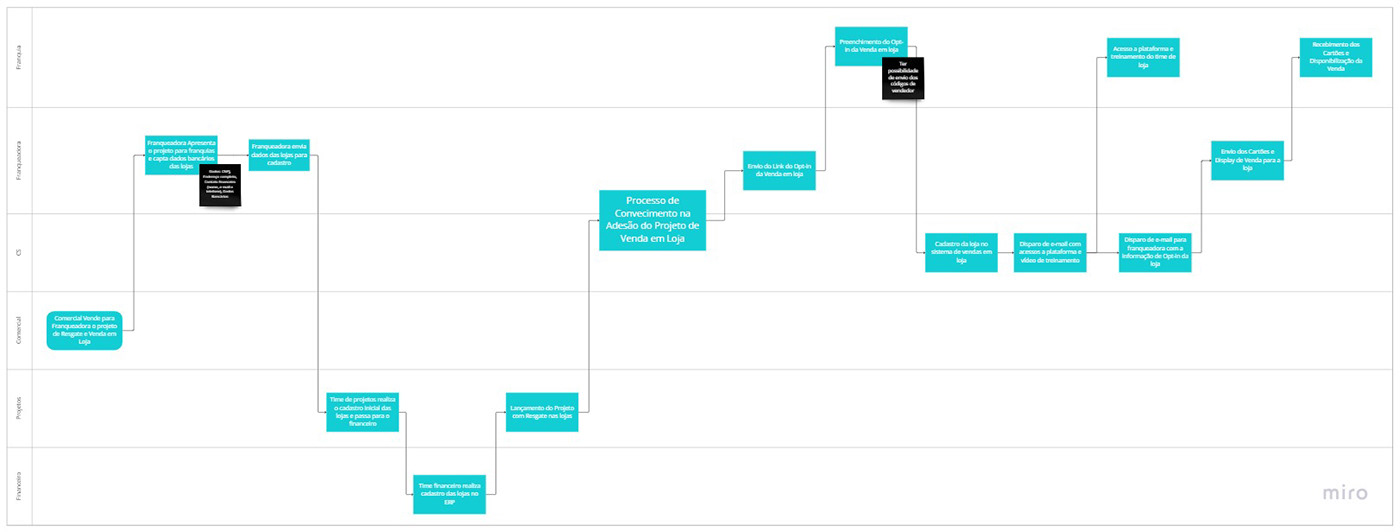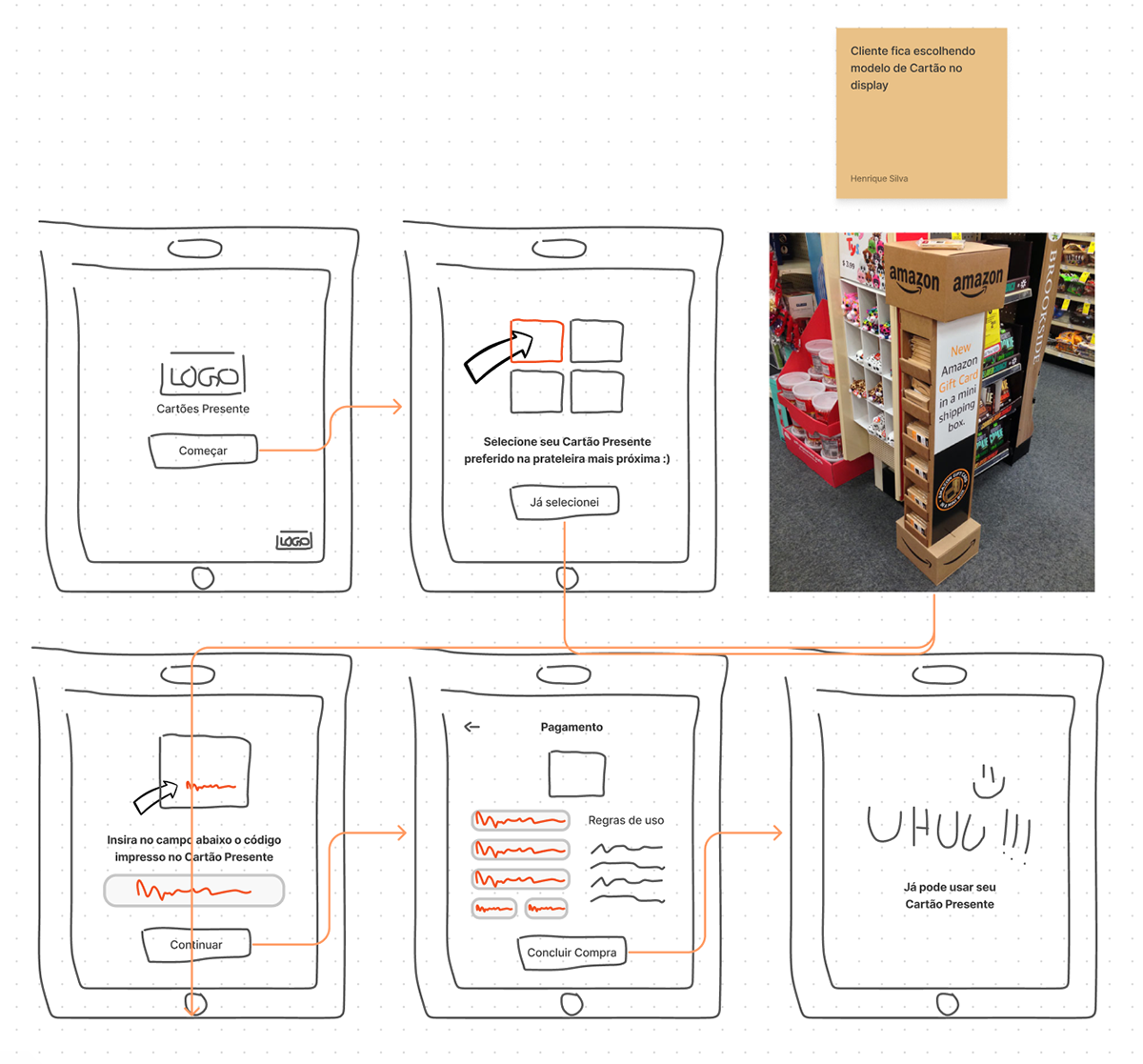
Gift card auto-selling journey
About Todo - a gift card company
A technology startup that creates gift lists and gift card solutions for retail.
Problem framing
For years, Todo's customer project team have been having several technical challenges in reaching their business goals, especially when they were stocked in scenarios of lack of communication with third-party suppliers or missed alignment between development teams from their own customers, causing several delivery delays in the and of the day and all along the technical integration.
Design sprint adoption
To build and plan our project roadmap, the Product Team followed the Design Sprint framework fundamentals, working with layered stages of progress during the project execution. We rearranged the design sprint original model to support our routine as a team, therefore, we didn't measure our activities in days, as usual, but instead of it, we measured the objective in stages.

Gathering information
The External Projects team
Our team, which included two project managers and me as a designer, started the project by collecting existing knowledge about our retailers, for which conversations were held with the External Projects team. During this stage, my team collected and undertood the External Projects team work routine and transformed this information into a journey map.

External project team activities journey
Desktop research
Were made many desktop benchmarking researchs to obtain more fresh experience from the retail industry, regarding new technologys and customer's behavior:

Desktop research with Amaro's store customer
Technical risk mitigation
After that, we started the technical validation with the Development team to understand our system's critical limitations.
Knowledge matrix
From these initial alignments, we set up a matrix of knowledge, assumptions and doubts to organize the collected information. We defined some items that were considered impeding and mandatory for the execution of the project, regardless of the solution that could come up.
- This helped time to define clearer and more limited objectives as future research related to the project.
Some of the items identified from the knowledge matrix were our success metrics:
- Easy retailers adoption
- Measurable
- Non-invasive user experience
- Non-invasive user experience
- Easy maintenance
- Technology reuse
Initial hypotheses
Brainstorm
“How to create something that should be easy to be managed by our team and won’t create a bizarre digital experience for our final customers and for our business core”
We created some prototypes, digital and physical, and we went outside the office to speak with representatives of the retailers, such as the marketing and innovation teams, to validate the challenge and also understand their point of view.
Initial prototyping
Were created some different touch points based on the same solution: the auto-vending journey focused on displays where the store visitant would buy and send their gift cards by themselves, just accessing a simplified webpage through a QR code.
- A marketing display that works together with a tablet would be able to create a complete gift card journey, from the buying stage to the sending.
- A QR Code printed on a marketing display the offers to the gift card buyers an e-commerce experience, but given then the option of select a physical gift card from the marketing display.
Inner stakeholder validation
Goal
- Identify gaps of experience though usability testing
- Identify technical gaps, such as financial obstacles or viability problems
Impact
From these researches, were gathered several and valuable information, such as business awareness, brand new insights, suggestions e perspectives that could improve, eventually, the product.
Retailer validation
Goal
- Measuring business interest
- Identify gaps of experience though usability testing
- Identify technical gaps, such as financial obstacles or viability problems
Were made many externa interviewing process with at least 5 Todo Company's retailers, from different categories of products and different brands.
Impact
From these interviewing and tests, many promising insights and very different perspectives emerged related to each of the retailers' niches, especially on the profile of end customers, such as age, adherence to new technologies and consumption journeys.
- Some retailers had end customers who were not in the habit of interacting with technology or social media;
- The face-to-face shopping experience with the seller's involvement was part of what consumers expected, so creating alternative solutions would be crucial to meet many retail niches.
- For laggard user, we created a hybrid journey where the store visitant would be able to pick up their gift card, goes to the front cashier and complete the payment stage through their own smartphone.


Customer validation
Goal
- Evaluate the user experience in the field when carrying out the journey at multiple points of purchase contact: Self-service Tablet, QR Code and Assisted Sale.
- Evaluate interface usability parameters
- Evaluate users' preference among the hypotheses available for interaction
Impact
The most selected solution to buy Gift Cards during the tests with final customers was the QR Code.
Recruitment summary
People who already have the habit of buying Gift Cards in person or online.
The guests' interaction with each hypothesis will be recorded in third person using a professional long-range tripod camera, in addition to heatmap tracking of navigation on the devices.
The script was divided into three distinct parts, with different objectives. The first part consists of selecting and initially approaching visitors ; the second part basically consists of presenting the guests (individually) with the counter that will support the hypotheses available for interaction; the third part of the script refers to only one of the hypotheses that was pre-selected by the team based on its business value and cost benefit.
- 1st part (Participant selection)
- 2nd part (Discovery of the preferred hypothesis)
- 3rd part (Validate hypothesis individually)
Each hypothesis presents its own range of items that will be analyzed quantitatively and qualitatively, based on data collected within the simulations with the device and the apparent perception of the individuals' behavior.
Tablet
- Was the guest able to easily start the stream in the tablet app?
- Was the guest able to understand the card template selection step?
- Was the guest able to easily find the Gift Card code?
- Was the guest able to set the charge amount on the card?
...
QR Code
- Was the guest able to easily start the journey by reading the QR Code on the display?
- Were the explanations about the types of gift cards clear?
- Was the guest able to easily find the Printed Gift Card code?
- Was the guest able to set the charge amount on the card?
- Was the guest able to fill in the credit card fields and complete the purchase?
- Options for all questions
...
Assisted Selling
Was the guest able to set the card charge value?
Was the guest able to fill in the credit card fields and complete the purchase?
Options for all questions
What is the apparent level of complexity at this step?
...
Some personas gathered directly from our Retailer's marketing people:
Expected tablet's user journey

Tablet wireframes





Display with QR code & smartphone user's journey







General statements
The main goal of this discovery project was going after the best solution to achieve business needs, as I have already said, but the whole process of discovery was too much important to identify what could be a bad idea as well, any kind of purpose how could eventually bring loss of time, money and create any sort of gap through the company process. It is the most part of a discovery project, more than identify opportunities, show to the stakeholder what could be bad for the business.
As result, this project rolled out a Betta test with some retailers how were interested, specially on the QR Code marketing display, this solution was very assimilated by the final customer, as consequence of the discovery process, the purpose of offering a tablet was canceled by our team regarding some maintenance aspects and the complexity of work with devices into retailer`s stores.
